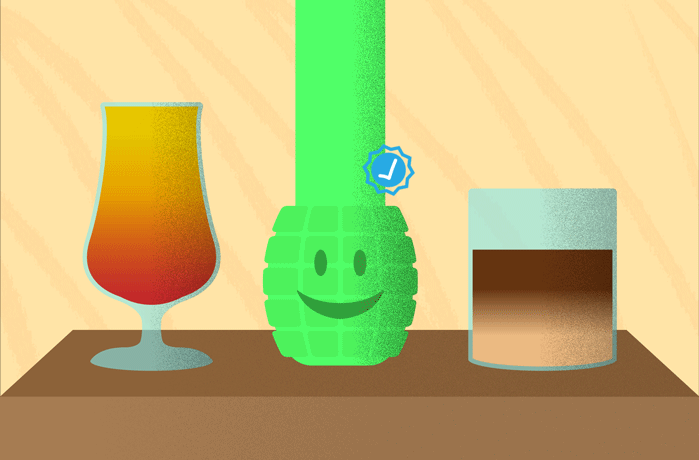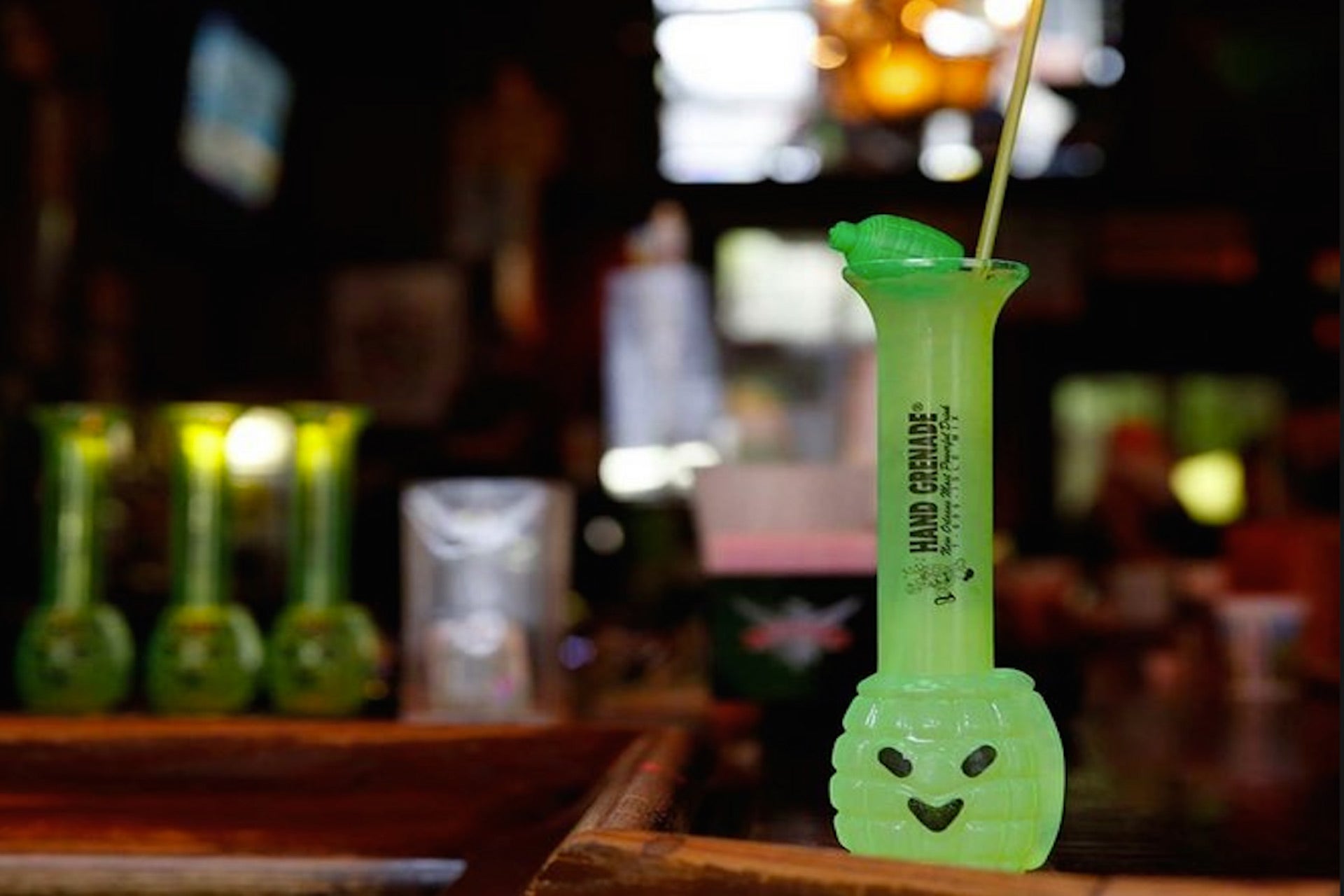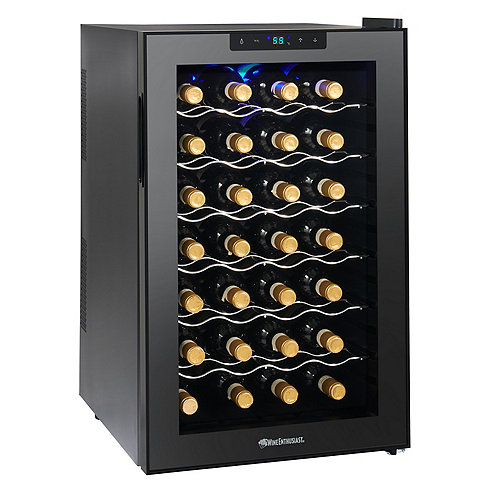Wine Enthusiast |
- Dark ‘n’ Legislated: Trademarked Cocktails Have Complicated Legacies
- Winemaking Ethos Meet Eco-Friendly Design at these Wineries
- Fruit-Forward and Complex: Nine Loire Valley White Wines for $42 or Less
| Dark ‘n’ Legislated: Trademarked Cocktails Have Complicated Legacies Posted: 05 May 2021 04:30 AM PDT  What value lies in trademarking a cocktail? It depends who you ask. Tropical Isle, a chain of bars in New Orleans, is the only place you can get a Hand Grenade®. There's pride in the ubiquitous nature of the drink in the city. "Every single Hand Grenade you see littering the streets of New Orleans is from one company," proclaims Tropical Isle's website. The pristine sanctity of a Hand Grenade, which Tropical Isle describes as a "melon flavor drink" with "lots of liqueurs" and "other secret ingredients" is dubious at best. But when it comes to other trademarked cocktails like the Dark 'n' Stormy, Sazerac or Painkiller, integrity is often cited as the need for the drink's legal designation.  Thanks to the trademarks, these cocktails must be made with certain, brand-name ingredients. Gosling's Black Seal Bermuda Black Rum must be added to a Dark 'n' Stormy. Sazerac Rye Whiskey is required for a Sazerac. Pusser's Rum is mandatory for the Painkiller. Otherwise, they are merely cocktails inspired by the originals. To the average person, this probably doesn't matter very much. The trademark holds more weight to businesses, which may be penalized for having made a Sazerac with any other rye. A trademark owner can issue a cease and desist letter to any establishment that doesn't abide by the drink's specifications. Malcolm Gosling Jr., of Gosling's Rum, says it's rare that the brand resorts to a cease and desist, but the company will protect its rights. "In order for a trademark to be effective, it must be maintained," says Gosling. "If the cocktail is misrepresented on a menu, we have found it is often an awareness issue. We will work with an account to fix the incorrect listing."
But it's virtually impossible to know how many people might be infringing upon your trademark, says attorney David Postolski. He specializes in intellectual property and patent law, and he's worked on a slew of food and drink patents. In spite of this, the few brands that have stayed devoted to their trademarked cocktails believe it's crucial for maintaining the integrity of the drink. "The trademark not only protects the integrity of the cocktail, it protects the consumer by ensuring they are actually getting a Dark 'n' Stormy," says Gosling. For a brand owner, there's confidence in having a strong, recognizable product, though Postolski warns that it can lessen with time. "The more your [trade]mark becomes generic, the more it loses power, becomes diluted," says Postolski.  This could explain why Jillian Vose, bar manager and beverage director at New York City's The Dead Rabbit, can't rattle off the short list of trademarked cocktails. None are on The Dead Rabbit's bar menu, though Vose is familiar with their basic formulations. She'll often use a classic cocktail's template to create a more modern interpretation. The bar's take on the Dark 'n' Stormy, for example, is crafted from ginger syrup, fresh lime juice, Gosling's and soda water. And if she doesn't have Gosling's? "I would use another blackstrap rum," says Vose. She doesn't believe the average person would detect the difference. Vose means no disrespect to these classic trademarked cocktails. She respects them and the general way they're supposed to be made, she says. All she really cares about is how the drink tastes. That's what the liquor companies that hold the trademarks claim, too. "You can make [a Painkiller] with Bacardi silver," says Gary L. Rogalski, president/CEO of Pusser's Rum, but "it's not going to taste like the Painkiller as we know it." Likewise, Gosling says, "you can make a Dark 'n' Stormy with another rum, but it will completely change the drink. Not to say it changes for the worse. The main thing is, it does change." Daniel Djang, founder of cocktail and spirits blog Thirsty in LA, says he will gladly enjoy a Sazerac made with the city’s "official" specs with Sazerac Rye, Herbsaint and Peychaud’s when he's in New Orleans at a landmark bar such as The Sazerac Bar or The Carousel Bar. And yet, "with today’s wide range of ryes, anise liqueurs and aromatic bitters, why should bartenders be limited to what one brand calls for?" says Djang. "Myself, I like bottled-in-bond workhorses like Old Overholt and Rittenhouse."
Djang says he's had countless Sazeracs, but he seriously doubts they were always made with Sazerac Rye. "Will Sazerac swoop down on every bar that doesn’t use their product in the Sazerac?" says Djang. "Hasn’t happened as far as I know." Sazerac did not respond to a request for comment. Pusser's, on the other hand, swooped down on a New York City bar named Painkiller in 2001. After Pusser's discovered the bar's namesake drink was not being made with Pusser's, the bar was forced to change its name. This garnered ill will in the bar community, according to Djang. A slew of publications covered the suit. "Was it worth it?" asks Djang. "You'll have to ask Pusser's."  Rogalski defended Pusser's position. He cited the integrity of the drink: four parts pineapple, one part cream of coconut, one part orange juice and however much rum you like. "People don't realize the responsibility of having a trademarked drink," he says. Perhaps the responsibility hints at why there aren't more trademarked drinks. Creativity around cocktails may be another. "Cocktails with spirits-only ingredients like a martini or Manhattan should be stirred, and you shake drinks with citrus like the daiquiri or margarita," says Djang. "But there are countless options for the base spirit and other ingredients, as well as their ratios." Different versions of a daiquiri, margarita or even a Negroni can be fun and a little personal, too. There's "marketing genius" behind trademarked cocktails, says Vose, who maintains she just wants to make the best-tasting drinks she can. She'd prefer to put a saline tincture in the margaritas she serves, but says she'll do a traditional salt rim if a customer wants it. "The pretentious bartender is a thing of the past," says Vose. |
| Winemaking Ethos Meet Eco-Friendly Design at these Wineries Posted: 05 May 2021 04:00 AM PDT  From the moment someone turns onto a lengthy driveway, enters through a Jurassic Park-like gate or rolls up to something reminiscent of a castle, all senses are engaged in a winery visit. Just like label design and packaging, much consideration goes into architecture and design of a winery. Wineries hope to elevate their wines through everything a visitor touches and sees. It's important, then, for modern wineries to be designed in ways that reflect the company's values, particularly as they coincide with organic and ecologically conscious winemaking. "The word 'sustainable' is tossed around a lot and there is ample liberty taken with it, but it doesn't mandate organic farming, which is something we do out of common sense," says Kashy Khaledi, proprietor of Ashes & Diamonds, a certified Napa Green producer. "Does it make sense to spray harmful chemicals a stone's throw away from guests enjoying their Ashes & Diamonds wines? Of course not." But what do winemaking choices have to do with design elements like 15-foot-high metal artwork or imported stone archways? Nothing concrete (pun intended). But the philosophies behind ethical winemaking are starting to seep into a more functional design.  As general manager and winemaker of Tantalus, British Columbia's first LEED-certified winery, David Paterson feels you don't need a lot of bells and whistles to make good wine. "You need good grapes to make good wine," says Paterson. "I find that when you get into the architecturally designed buildings with all sorts of curves or false walls, they’re usually down on efficiency in favor of design aspects." Energy conservation at Tantalus focuses on the winemaking facility, with efficient insulation and Joule heat exchanges. "In a way, we built one massive fridge," says Paterson. "The energy use when it’s minus-15° Celsius [5° Farenheit] outside is a lot less than if we weren’t as well insulated." The Okanagan Valley can see temperatures upward of 40°C, or 104°F, in the summer, so less energy is needed to keep the space cool. The use of natural elements is another resourceful way to influence design. In Mendoza, Argentina, Sebastián Zuccardi says the creation of Zuccardi Valle de Uco, opened in 2016, was inspired by the Andes. "The construction emerges from the soil, and it is part of it because it was made with natural elements such as round, white and calcareous stones, sand and water," says Zuccardi. "It is also made of concrete from the outside to inside, from the stone walls to concrete vats inside."  Modern constructs aren't always the answer. When Ashes & Diamonds was built in 2016, its team dove decades into the past to inspire the efficient and economical construction of the tasting room bar. "The mid-century Californian Case Study Houses served as the template for us when thinking of what our tasting room would look and feel like," says Khaledi. "The folded rooves from Donald Wexler homes in Palm Springs morphed into a floating folded roof above the hospitality building that created a massive, shaded surface area for outdoor seating." The production facility at Ashes & Diamonds mirrors much of the philosophy of Tantalus: no-frills function with flat metal surfaces that are easy to clean. "We really put the 'nothing' in nothing fancy here," says Khaledi. "Our wines are made with minimal intervention and rarely if ever do we filter. Keeping microbials out is part of this discipline, so cleanliness is key." Implementing nitty-gritty details into the design falls to the architect. Tom O’Neil, from Virginia-based O'Neil Architects, says his portfolio is comprised of about 20% wineries scattered across Northeastern U.S. Sustainable concept and design are at the top of nearly every winery's list. "There's often discussion about the use of recycled materials or using certain framing techniques to conserve lumber," says O'Neil. "Just about any winery is going to have good exposure to the sun, so photovoltaic panels usually come into discussion." Since the start of the novel coronavirus pandemic, additional factors have borne more weight in design considerations. "I’d say the two biggest things are the ventilation requirements, making sure [the] HVAC system can bring plenty of fresh air into the building, and then the other is thinking about indoor-outdoor spaces more," says O'Neil. "Even before Covid, most wineries realize that people want to be outside, so roll-up doors to create big open spaces have become quite popular." Such considerations are expected to continue as spaces reopen and new ones are designed, fueled by strategies for long-term sustainability and success. |
| Fruit-Forward and Complex: Nine Loire Valley White Wines for $42 or Less Posted: 05 May 2021 03:30 AM PDT  France's Loire Valley offers a wealth of delicious white wines. There are three standout varieties: Melon de Bourgogne, Chenin Blanc and Sauvignon Blanc. If you want a bottle that's less fruit-forward and has more mineral flavors, grab a Melon de Bourgogne or Muscadet. These wines are known for citrus and saline flavors, and for being the perfect oyster pairing. It's also common for Loire's Muscadet to be aged sur lie, meaning they have been allowed to rest on the dead yeast cells, which adds depth and texture to bottles. Multiple appellations such Anjou, Saumur and Vouvray, produce sparkling, dessert or still Chenin Blanc. And these bottles are much like their counterparts in South Africa. The Loire Valley's still Chenin ranges from austere and mineral driven to rich and fruity. Sometimes these Chenins are aged in oak. Sauvignon Blanc is responsible for the iconic white wines of Sancerre and are the most famous wines from the Loire. Much like the region's Muscadet wines these bottles often display intense mineral tones but also bring grassy herbaceous notes or ripe stone fruit flavors. They can be weightier white wines bordering on full-bodied, even without the boost of oak aging. But there are also oak-aged Sancerres. Melon de Bourgogne Domaine de l’Epinay 2017 Cru Clisson (Muscadet Sèvre et Maine); $25, 93 points. Clisson is one of the new generation of cru villages in Muscadet, with wines aged for several years before release. Matured on lees for three years, this wine has rich, ripe mango and pear flavors and maturity that is just right. Drink now. Schatzi Wines. Editors' Choice. —Roger Voss Guilbaud Frères 2019 Clos de Beauregard Sur Lie (Muscadet Sèvre et Maine); $16, 91 points. Lees aging for six months, has given this ripe and fruity wine density as well as attractive richness. Baked apple and pear flavors bring some warmth to the mineral texture and the citrus aftertaste. The wine has a crisp, fresh aftertaste. Drink now. Grape Expectations (CA). Editors' Choice. —R.V. Domaine Batard Langelier 2018 Didascalie Sur Lie (Muscadet Sèvre et Maine); $20, 90 points. From vines planted in magma soil, this is a textured, mineral wine. A tangy character suggests citrus as well as kiwi fruits. The wine is cool, crisp and now ready to drink. Savio Soares Selections. —R.V. Chenin Blanc Saget la Perrière 2014 Château de la Mulonnière L’Effet Papillon (Savennières); $34, 93 points. This is now a rich, mature Chenin Blanc. Its name indicates that fruit comes from the famed Clos du Papillon vineyard of Savennières, giving the wine ripeness and density. The acidity and quince flavors harmonize well. Drink now. Taub Family Selections. —R.V. Domaine de l’Enchantoir 2019 Terres Blanches (Saumur); $20, 92 points. Matured on its lees to give extra richness, this wine is packed with mango and yellow fruits as well as citrus. A taste of honey hovers in the background of this wine. Drink from 2022. Organic. Skurnik Wines, Inc. —R.V. Xavier et Agnès Amirault 2018 Les Quarterons Chenin Blanc (Anjou); $37, 91 points. This rich, wood aged wine is impressively structured, with ripe spice, almonds and an inspiring floral character. The round, supple texture and yellow fruits are generous. Although ready to drink, the wine will age at least until 2024. Vineyard Brands. —R.V. Sauvignon Blanc Domaine Vacheron 2018 Sancerre; $42, 92 points. As it matures, this wine gains in depth and concentration. Ripe green apple and zingy citrus flavors have opened up, bringing good texture and complex structure to the fruitiness. Drink now. Organic and biodynamic. Terlato Wines International. —R.V. We Recommend: Pierre Morin 2018 Chêne Marchand (Sancerre); $29, 92 points. From the famed vineyard, this wine shows richness and intense white fruits. Herbal and green elements give a crisp edge to the dense texture and perfumed, floral aftertaste. Drink now. Weygandt-Metzler. —R.V. François Crochet 2018 Les Amoureuses (Sancerre); $40, 91 points. From a vineyard with rich clay and chalk soil, this wine is dense and full of ripe fruit. A zesty edge and touches of minerality contrast with the ripe fruits that offer hints of apricots as well as crisp citrus. Drink from 2021. Organic and biodynamic. Old World Imports LLC. —R.V. |
| You are subscribed to email updates from Wine Enthusiast. To stop receiving these emails, you may unsubscribe now. | Email delivery powered by Google |
| Google, 1600 Amphitheatre Parkway, Mountain View, CA 94043, United States | |

















0 comments:
Post a Comment